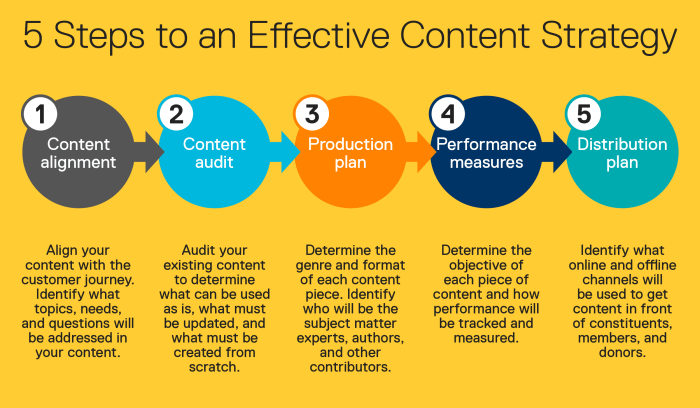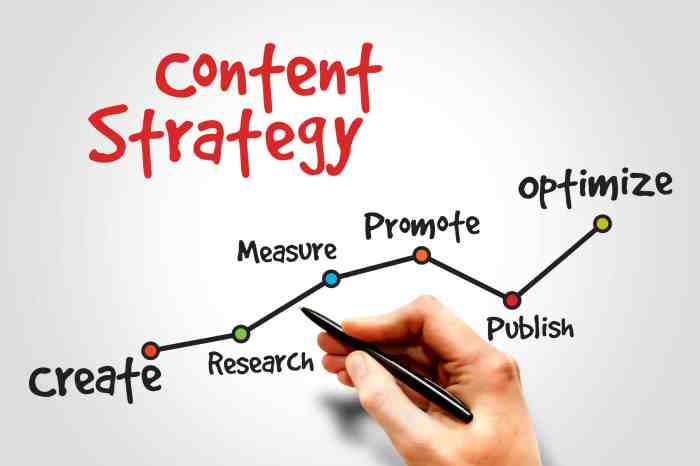Developing Content Strategies sets the stage for businesses to thrive in a digital world, where every word counts and every click matters. Let’s dive into the art of strategic content planning and unleash the power of captivating storytelling.
From understanding your audience to creating high-quality content and mastering distribution channels, this guide will navigate you through the dynamic landscape of content creation.
Importance of Content Strategy: Developing Content Strategies
Content strategy plays a crucial role in the success of businesses in today’s digital age. It involves planning, creating, and managing content to attract and retain a target audience. Here’s why it’s essential:
Enhanced Visibility and Engagement
A well-developed content strategy increases a company’s visibility online, making it easier for potential customers to find them. By consistently delivering valuable and relevant content, businesses can engage their audience and build relationships that lead to customer loyalty.
Establishing Credibility and Trust
Companies like HubSpot and Buffer have seen significant growth and success by implementing strong content strategies. HubSpot’s blog, for example, provides valuable resources for marketers and has helped establish the company as a thought leader in the industry.
Consequences of Neglecting Content Strategy
On the flip side, failing to have a solid content strategy in place can have detrimental effects on a business. Without a clear direction for content creation, companies may struggle to connect with their target audience, resulting in decreased visibility, engagement, and ultimately, loss of potential customers.
Understanding Target Audience

When developing a content strategy, it is crucial to understand the target audience to create relevant and engaging content. Identifying and defining the target audience involves researching their demographics, interests, behaviors, and preferences to tailor the content specifically to their needs.
The Role of Demographic Research
Demographic research helps in understanding the target audience by providing key information such as age, gender, location, income level, education, and more. For example, a skincare brand targeting young adults would focus on creating content that resonates with this demographic, such as skincare routines for acne-prone skin or affordable product recommendations for college students.
- Age: Knowing the age range of the target audience helps in determining the tone and style of content, whether it should be more formal or casual.
- Location: Understanding the geographical location can influence the language used, cultural references, and even the type of products/services promoted.
- Income Level: This factor can impact the pricing strategy, product recommendations, and the overall messaging to align with the audience’s purchasing power.
Demographic research provides valuable insights into the target audience’s characteristics, enabling content creators to tailor their messaging effectively.
Psychographic Factors in Content Tailoring
Psychographic factors play a crucial role in tailoring content to specific audience segments by focusing on their values, beliefs, interests, and lifestyles. For instance, understanding that a segment of the target audience values sustainability and eco-friendly practices can guide content creation towards promoting environmentally-conscious products or initiatives.
- Values: Crafting content that aligns with the target audience’s core values can establish a deeper connection and foster brand loyalty.
- Lifestyles: Tailoring content to match the audience’s lifestyle choices and preferences ensures relevance and resonance with their daily experiences.
- Interests: Developing content around topics that interest the target audience increases engagement and encourages interactions with the brand.
Psychographic factors provide a more nuanced understanding of the target audience, allowing content creators to create meaningful and impactful content that resonates on a personal level.
Content Planning and Ideation

Content planning and ideation are crucial steps in creating a successful content strategy. It involves brainstorming sessions to generate creative ideas that align with business goals and audience needs.
Steps in Creating a Content Plan
- Identify business objectives and goals.
- Research target audience demographics and preferences.
- Conduct a content audit to assess existing content and identify gaps.
- Create a content calendar to plan and organize content creation and distribution.
- Define key performance indicators (KPIs) to measure the success of the content strategy.
Importance of Brainstorming Sessions
Brainstorming sessions are essential for generating fresh and innovative content ideas. They allow team members to collaborate, share perspectives, and think outside the box. By pooling together diverse ideas, brainstorming sessions can lead to creative solutions and unique content concepts.
Aligning Content Ideas with Business Goals and Audience Needs
To ensure that content ideas resonate with both business objectives and audience preferences, it’s important to align them strategically. This can be achieved by:
- Mapping content ideas to specific business goals and objectives.
- Considering the interests, challenges, and preferences of the target audience.
- Personalizing content to cater to the unique needs of different audience segments.
- Measuring the performance of content against KPIs to evaluate its impact on achieving business goals.
Content Creation and Optimization
When it comes to creating high-quality content, there are a few best practices to keep in mind. From engaging writing to eye-catching visuals, every detail matters in capturing your audience’s attention and keeping them coming back for more.
Best Practices for Creating High-Quality Content
- Focus on providing value to your audience through informative and relevant content.
- Use a mix of text, images, videos, and infographics to make your content visually appealing.
- Ensure your content is well-researched, accurate, and free of grammatical errors.
- Incorporate storytelling techniques to make your content more engaging and memorable.
- Regularly update and refresh your content to keep it relevant and up-to-date.
Significance of in Content Optimization, Developing Content Strategies
, or Search Engine Optimization, plays a crucial role in ensuring your content is discoverable by your target audience. By optimizing your content for relevant s, meta tags, and other factors, you can improve your content’s visibility on search engines and drive organic traffic to your website.
Tips for Repurposing Content Effectively
- Repurpose blog posts into social media snippets, infographics, or videos to reach a wider audience.
- Create a series of related content pieces that can be repurposed into ebooks, webinars, or podcasts.
- Turn user-generated content, such as customer reviews or testimonials, into engaging social media posts or case studies.
- Update and repurpose evergreen content to keep it relevant and valuable to your audience over time.
Content Distribution Strategies
In the world of content creation, it’s not just about producing great material – you also need to get it in front of the right eyes. This is where content distribution strategies come into play. By utilizing various channels for distributing content, such as social media, email marketing, and more, you can maximize the reach and impact of your content.
Importance of a Multichannel Approach
When it comes to reaching a wider audience, a multichannel approach is key. By utilizing multiple distribution channels, you can ensure that your content is seen by a diverse range of individuals who may not all frequent the same platforms. This helps increase brand awareness, drive traffic, and ultimately lead to better engagement with your content.
- Utilize social media platforms like Facebook, Twitter, Instagram, and LinkedIn to share your content with a wide audience.
- Incorporate email marketing campaigns to reach out directly to your subscribers and keep them engaged with your content.
- Consider guest posting on industry-relevant websites or partnering with influencers to expand your reach even further.
Remember, the more channels you utilize, the more opportunities you have to connect with your target audience and drive results.
Role of Analytics in Measuring Effectiveness
Analytics play a crucial role in measuring the effectiveness of your content distribution strategies. By tracking key metrics such as website traffic, social media engagement, email open rates, and more, you can gain valuable insights into what’s working and what’s not. This data allows you to make informed decisions about where to focus your efforts and optimize your distribution strategies for maximum impact.
- Use tools like Google Analytics, social media analytics platforms, and email marketing software to track and analyze the performance of your content.
- Pay attention to metrics like click-through rates, conversion rates, and audience demographics to understand how your content is resonating with different segments of your audience.
- Regularly review and adjust your distribution strategies based on the data to ensure continuous improvement and better results over time.
Content Calendar Management
Setting up and managing a content calendar is crucial for maintaining a consistent and organized content strategy. By planning ahead and scheduling your content in advance, you can ensure that you are delivering timely and relevant information to your audience. Here’s a guide to help you get started.
Benefits of Scheduling Content in Advance
- Consistency: By scheduling your content in advance, you can maintain a consistent posting schedule, which helps build trust and loyalty with your audience.
- Efficiency: Planning ahead allows you to batch create content and streamline your workflow, saving time and effort in the long run.
- Flexibility: Having a content calendar in place gives you the flexibility to make adjustments as needed and adapt to changing circumstances.
- Improved Quality: Planning ahead gives you the time to create high-quality content that resonates with your audience, leading to better engagement and results.
Tips for Adjusting Content Calendars
- Monitor Trends: Keep an eye on real-time events, industry trends, and audience interests to identify opportunities for timely and relevant content.
- Stay Agile: Be prepared to adjust your content calendar on the fly to capitalize on emerging opportunities or address unexpected challenges.
- Plan for Contingencies: Have backup content ideas ready in case your original plan needs to be revised due to unforeseen circumstances.
- Engage with Your Audience: Pay attention to feedback and engagement metrics to understand what content is resonating with your audience and adjust your calendar accordingly.
Evaluating Content Performance
When it comes to evaluating content performance, there are key metrics that are commonly used to measure how well your content is doing, tools and platforms to track engagement, and strategies to improve based on analysis.
Key Metrics for Measuring Content Performance
- Page Views: The number of times a page has been viewed by users.
- Unique Visitors: The number of individual users who have visited a page.
- Time on Page: The average amount of time users spend on a page.
- Bounce Rate: The percentage of visitors who navigate away from the site after viewing only one page.
Tools and Platforms for Tracking Content Engagement
- Google Analytics: Provides detailed insights into website traffic, user behavior, and more.
- Social Media Analytics: Platforms like Facebook Insights and Twitter Analytics offer data on post performance.
- Email Marketing Platforms: Tools like Mailchimp track email open rates, click-through rates, and more.
Strategies for Continuous Improvement
- Regularly Analyzing Data: Review metrics to identify trends, patterns, and areas for improvement.
- A/B Testing: Experiment with different content formats, headlines, or visuals to see what resonates best with your audience.
- Optimizing : Ensure content is optimized for search engines to improve visibility and reach.